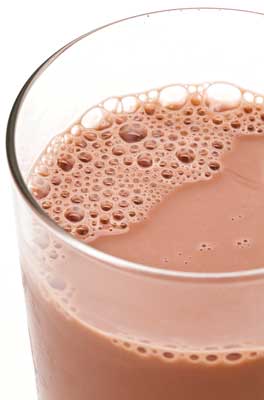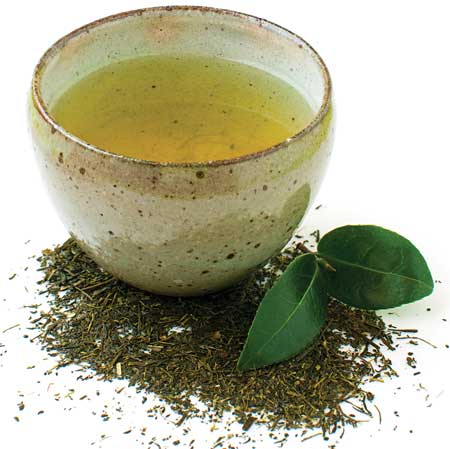Burning Fat, Building Muscle
NUTRACEUTICALS
Dedicated athletes, weekend warriors, dieters, and Baby Boomers all share a common concern of burning unwanted fat, building lean muscle mass, or both. Today’s ingredients are more sophisticated in both functionality and effectiveness on fat and/or muscle. These run the gamut from proteins to conjugated linoleic acid to green tea catechins. Here is a review of some of these ingredients that may help to burn fat and build muscle.
 Conjugated Linoleic Acid
Conjugated Linoleic Acid
Conjugated linoleic acid (CLA) is known to improve overall body composition. Information from BASF Nutrition & Health, Florham Park, N.J. (newtrition.basf.com), explains that CLA works in four ways. It decreases the number and size of adipocytes (fat cells), lowering body fat mass. It decreases the activity of lipoprotein lipase enzymes, which help to store triglycerides (fats) in adipocytes (fat cells). With regular use of CLA, less fat gets stored. Third, CLA increases apoptosis, the rate at which fat cells disintegrate, thus reducing the number of existing fat cells in the body. CLA also increases activity of the enzyme carnitine palmitoyltransferase, so fat is burned up faster.
Tonalin CLA from BASF Nutrition & Health (tonalin.com) is a nutritional ingredient sustainably sourced from safflower oil, a vegetarian source of linoleic acid. “Given that Tonalin CLA has been clinically proven to help reduce body fat by up to 10%, while increasing lean muscle mass, the demographic profile could encompass a broad segment of the adult population beyond athletes,” observes Eva Johnson, marketing manager at BASF Nutrition & Health. “This could include a range of consumer segments from fitness enthusiasts to people living active lifestyles.
“Tonalin is the most clinically researched CLA on the market. The safety and effectiveness of Tonalin has been proven in 18 separate research studies,” states Johnson. The suggested intake is 3 g of Tonalin CLA/day. A minimum dosage of 1.7 g of CLA/day is recommended to achieve body fat reduction.
BASF Nutrition & Health recently sponsored a webinar in which the company presented new research on the benefits of CLA that went beyond fat loss. In the webinar, Mark Cook, professor at the University of Wisconsin and a pioneer in CLA research, discussed the research he conducted that shows a promise of CLA as a potential anti-inflammatory and immune-modulating agent in preliminary trials.
 Green Tea Polyphenols
Green Tea Polyphenols
Green tea, in general, boasts benefits ranging from antioxidant activity to detoxifying properties and energizing benefits. The polyphenols or catechins in green tea account for many of these benefits. Preliminary research suggests that tea flavonoids help elevate metabolic rate, increase fat oxidation, and improve insulin activity.
Roberts et al. (2015) demonstrated the cardio–metabolic and antioxidant health benefits of decaffeinated green tea extract related to its catechin polyphenol content. Fourteen recreationally active males were randomly assigned capsulated decaffeinated green tea extract (571 mg) or a placebo for 4 weeks. Following body composition and resting cardiovascular measures, participants cycled for 1 hour at 50% VO2peak, followed by a 40 minute performance trial at weeks 0, 2, and 4. The results showed that the total fat oxidation rates increased and body fat significantly decreased in the subjects who took the the green tea extract. The results supported the use of catechin polyphenols from decaffeinated green tea extract in combination with exercise training in recreationally active subjects.
Maki et al. (2009) suggested that green tea catechin consumption enhanced exercise-induced changes in abdominal fat and serum triglycerides. The researchers randomly assigned 107 overweight and obese adults to receive a beverage containing approximately 625 mg of catechins and 39 mg of caffeine or a control beverage containing 39 mg of caffeine and no catechins for 12 weeks. There was a trend toward greater loss of body weight in those who consumed the beverage with catechins. Percentage changes in total abdominal fat area, subcutaneous abdominal fat area, and fasting serum triglycerides were also greater in this group of subjects.
Taiyo International, Minneapolis, Minn. (taiyointernational.com), offers Sunphenon green tea catechin extract. Exhibiting thermogenic effects, Sunphenon is produced from pesticide-controlled green tea leaf, extracted via a water infusion process, and decaffeinated using only approved food-grade solvents.
Protein
When it comes to building and/or maintaining lean muscle, protein is the ingredient of choice. Athletes, people trying to lose weight, and the aging population are all concerned with maintaining the lean muscle they possess and consuming enough protein.
Researchers conducted a study to establish whether the loss of muscle mass during weight loss could be counteracted by a two-pronged approach: ensuring that the protein provided by a reduced-calorie diet is balanced throughout the day rather than the usual tendency to receive the bulk of daily protein intake from the evening meal, and exercising regularly in the form of resistance training (Nestlé Research Center 2015; Murphy et al. 2015). Twenty obese men around the age of 65 were recruited for the four-week study. For the first two weeks, they were placed on a low-calorie, high-protein diet and continued with their normal daily activity. However, half of the subjects received a balanced intake of protein from the four meals/protein drinks provided throughout the day, while the second half received the more standard “skewed” diet, with the majority of their protein intake coming from the evening meal. In the second two weeks of the study, the diet was combined with a whole-body, progressive resistance exercise regime to see if it would counteract any negative impact of the reduced-calorie diet on muscle mass. Rates of muscle protein synthesis were measured at the end of each phase by blood sampling and muscle biopsy.
Both groups of subjects displayed reduced fat mass and reduced muscle mass during the first half of the study when both groups were on a low-calorie, high-protein diet and did not perform resistance training. While the fat reduction was the same for both groups, the reduction in muscle protein synthesis rate was less marked in those who received the balanced intake of protein. During the second half of the study, which included resistance training, both groups continued to lose body fat, but muscle loss was noticeably slower than after the first half of the study. In fact, the protein synthesis observed in the subjects in the balanced intake group was comparable to the levels seen with “normal” energy intake before the study began.
The research demonstrated that a reduced-calorie diet reduces the rate of muscle protein synthesis, confirming that weight loss can also lead to muscle loss. However, the study also demonstrated that a balanced protein intake throughout the day increased muscle protein synthesis when compared to a skewed protein distribution. This beneficial effect is further enhanced when combined with resistance training.
 When it comes to building and maintaining lean muscle mass, whey protein is one of the main protein ingredients that can be found in high-protein drinks and foods. Much research has focused on whey protein’s benefits in the areas of lean muscle mass as well as satiety and weight management. For those looking for a vegetarian and nondairy source of protein, pea protein is an up-and-coming alternative that research is showing to be beneficial in muscle building as well.
When it comes to building and maintaining lean muscle mass, whey protein is one of the main protein ingredients that can be found in high-protein drinks and foods. Much research has focused on whey protein’s benefits in the areas of lean muscle mass as well as satiety and weight management. For those looking for a vegetarian and nondairy source of protein, pea protein is an up-and-coming alternative that research is showing to be beneficial in muscle building as well.
Whey protein is a high-quality, complete protein that is readily digested and absorbed by the body, and it contains all of the essential amino acids. It is also high in the branched-chain amino acid leucine.
Hector et al. (2015) showed that whey protein supplementation may be important in the preservation of lean muscle mass during longer-term weight loss intervention. The researchers wanted to determine how the consumption of different sources of proteins (soy or whey) during a controlled short-term (14 days) hypoenergetic diet affected muscle protein synthesis and lipolysis. The overweight and obese subjects (19 men and 21 women) were randomly assigned, double blind, to receive twice-daily supplements of isolated whey (27 g/supplement) or soy (26 g/supplement), or isoenergetic carbohydrate (25 g of maltodextrin/supplement). Preintervention, muscle protein synthesis was stimulated more with ingestion of whey protein than with soy protein or carbohydrate. Muscle protein synthesis decreased similarly in all groups during the calorie-restricted diet, however the whey protein supplementation attenuated the decline in the postprandial rates of muscle protein synthesis after weight loss, which may be of importance in the preservation of lean mass during longer-term weight loss interventions.
Whey protein ingredients are getting more refined and versatile. Last year, Arla Foods Ingredients, Viby J, Denmark (arlafoodsingredients.com), developed a whey protein ingredient for creating yogurt-based sports nutrition products. The Nutrilac ingredient makes it easy to produce delicious drinkable sports yogurt products with a pleasant taste and texture just like a standard drinkable yogurt, but with a whey protein content as high as 28 g/serving. Sports yogurts formulated with the ingredient can be produced in a variety of flavors and packaged in bottles or pouches, formats that are already well-established and popular in the fast-growing sports nutrition category.
The company also offers its cutting-edge Lacprodan DI-7017, a 100% whey protein concentrate that is ultra-high-temperature stable, offers neutral pH, and tastes good. These attributes make it especially attractive to manufacturers wishing to develop long-shelf-life products designed for weight management and the increase of muscle mass.
Pea protein is showing up in more muscle-building and high-protein products. It offers a vegetarian source of protein and most recently was shown to benefit muscle thickness. Babault et al. (2015) showed that in addition to an appropriate training, supplementation with pea protein promoted a greater increase of muscle thickness as compared to a placebo, especially for people starting or returning to muscular strengthening. The study involved 161 males aged 18 to 35 years who underwent 12 weeks of resistance training on upper limb muscles. The subjects were randomized into one of three groups to receive either pea protein, whey protein, or a placebo. All of the subjects took 25 g of the proteins or placebo twice a day. Muscle thickness and muscle strength increased with time in those who consumed pea protein and whey protein compared to those who consumed the placebo. Since no difference was obtained between the two groups of subjects who consumed the protein ingredients, the researchers concluded that vegetable pea proteins could be used as an alternative to whey-based dietary products.
Roquette, Lestrem, France (roquette-food.com, nutralys-vegetable-proteins.com), manufactures NUTRALYS pea protein, the pea protein ingredient used in the study. NUTRALYS offers an excellent digestibility rate (98%), benefits from a balanced amino acid profile, and is rich in arginine and lysine. Another advantage is that it is non-allergenic.
Next month’s Nutraceuticals section will highlight some of the healthful ingredients and product concepts presented at the IFT15 event.
www.ift.org
Members Only: Read more about ingredients that may help build muscle and burn fat online at ift.org. Type the keywords into the search box at the upper right side of the home page.
 Linda Milo Ohr,
Linda Milo Ohr,
Contributing Editor
Denver, Colo.
[email protected]
References
Babault, N., C. Païzis, G. Deley, L. Guérin-Deremaux, M.-H. Saniez, C. Lefranc-Millot, and F. A. Allaert. 2015. “Pea Proteins Oral Supplementation Promotes Muscle Thickness Gains during Resistance Training: A Double-blind, Randomized, Placebo-controlled Clinical Trial vs. Whey Protein.” J. Int. Soc. Sports Nutr. 12:3. doi: 10.1186/s12970-014-0064-5.
Hector, A. J., G. R. Marcotte, T. A. Churchward-Venne, C. H. Murphy, L. Breen, M. von Allmen, S. K. Baker, and S. M. Phillips. 2015. “Whey Protein Supplementation Preserves Postprandial Myofibrillar Protein Synthesis during Short-term Energy Restriction in Overweight and Obese Adults.” J. Nutr. 145(2): 246–252. doi: 10.3945/jn.114.200832.
Maki, K. C., M. S. Reeves, M. Farmer, K. Yasunaga, N. Matsuo, Y. Katsuragi, M. Komikado, I. Tokimitsu, D. Wilder, F. Jones, J. B. Blumberg, and Y. Cartwright. 2009. “Green Tea Catechin Consumption Enhances Exercise-induced Abdominal Fat Loss in Overweight and Obese Adults.” J. Nutr. 139(2): 264–270.
Murphy C. H, T. A. Churchward-Venne, C. J. Mitchell, N. M. Kolar, A. Kassis, L. G. Karagounis, L. M. Burke, J .A. Hawley, and S. M. Phillips. 2015. “Hypoenergetic Diet-induced Reductions in Myofibrillar Protein Synthesis are Restored with Resistance Training and Balanced Daily Protein Ingestion in Older Men.” Am. J. Physiol. Endocrinol. Metab. doi: 10.1152/ajpendo.00550.2014.
Nestlé Research Center. 2015. “Lose the Fat, Keep the Muscle—Nestlé Research Center Shows.” Press release, March 13. Nestlé Research Center, Lausanne, Switzerland. research.nestle.com.
Roberts, J. D., M. G. Roberts, M. D. Tarpey, J. C. Weekes, and C. H. Thomas. 2015. “The Effect of a Decaffeinated Green Tea Extract Formula on Fat Oxidation, Body Composition and Exercise Performance.” J. Int. Soc. Sports Nutr. 12:1.


